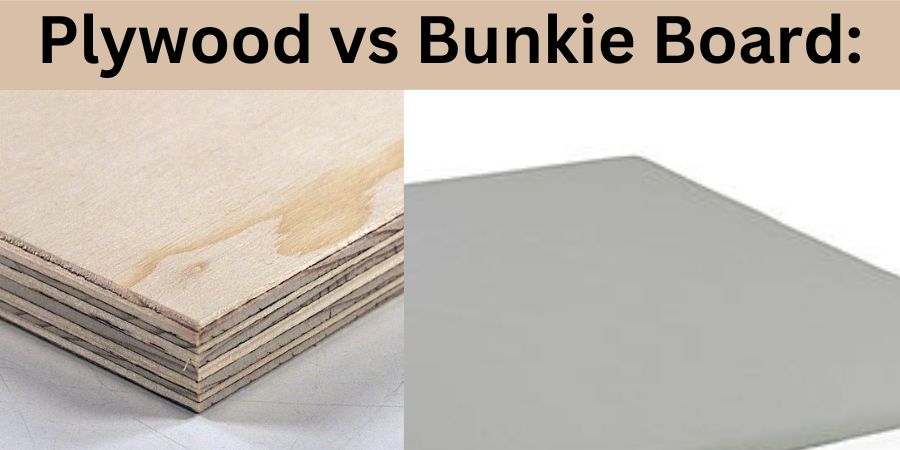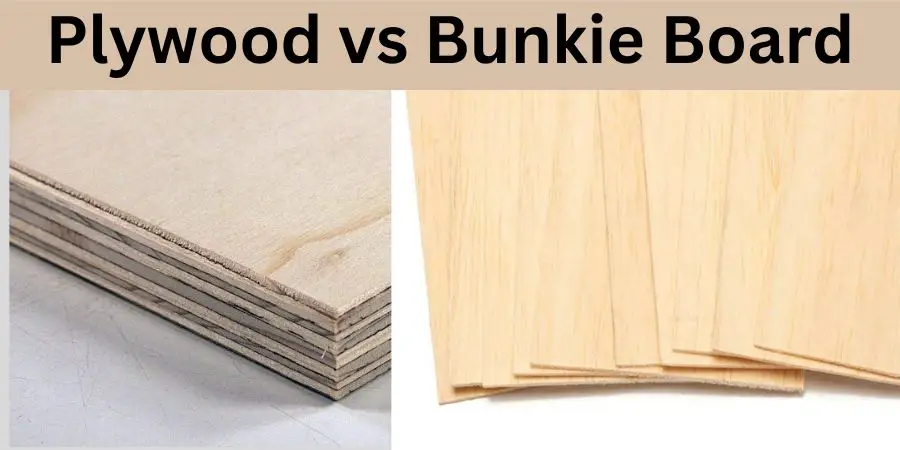As a carpenter or DIYer, you might be wondering what to use as a base for your bed frame: plywood or a bunkie board?
While both options can provide support for your mattress, they have different characteristics that may affect your decision.
In this blog post, we’ll compare plywood vs bunkie board and help you choose the best option for your needs.
Plywood vs Bunkie Board

The big difference between plywood and bunkie board for a bed is their structure and function.
Plywood is a thicker and more durable option that can provide excellent support for your mattress and offer more versatility in terms of design and functionality.
Bunkie board, on the other hand, is a thinner and simpler option that is designed to support a mattress without adding extra height to the bed frame.
If you want a strong and long-lasting base for your bed frame, plywood is the way to go.
But if you prefer a minimalist and low-profile look, a bunkie board may be more suitable. Just make sure to choose the right one for your mattress type and sleep preferences!
What is Plywood?
Plywood is a type of engineered wood made from thin layers of wood veneers that are glued together in alternating directions.
The result is a strong, stable, and flat sheet of wood that can be used for a variety of applications, including furniture, flooring, and construction.
Plywood comes in different grades, thicknesses, and finishes, and can be customized to fit specific requirements.
What is a Bunkie Board?
A bunkie board, also known as a foundation board or a bunkie mattress, is a thin and solid platform made of wood or particleboard.
It is designed to support a mattress without adding extra height to the bed frame.
Bunkie boards are commonly used in bunk beds, daybeds, trundle beds, and low-profile bed frames.
Comparing Plywood vs Bunkie Board
Let’s take a closer look at how plywood and bunkie board compare in terms of strength, durability, cost, and versatility.
Strength and Durability
Plywood is generally stronger and more durable than a bunkie board due to its layered construction and adhesive bonding. It can withstand heavier weight, pressure, and stress without cracking, warping, or splitting.
Plywood also has better resistance to moisture, insects, and fire, depending on the type of wood species and treatment used.
A bunkie board is not as strong or durable as plywood because it is a single solid board that can bend, flex, or sag over time, especially if it is made of low-quality wood or particleboard.
Bunkie boards are more suitable for lightweight and occasional use, such as in guest rooms or children’s rooms.
Cost
Plywood is generally more expensive than a bunkie board due to its higher quality and customization options. The cost of plywood can vary depending on the thickness, grade, species, and finish.
However, plywood can last longer and require less maintenance than a bunkie board, making it a better investment in the long run.
A bunkie board is generally cheaper than plywood due to its simpler design and lower quality. The cost of a bunkie board can vary depending on the size, material, and brand.
However, bunkie boards may need to be replaced more often than plywood due to wear and tear, making them a more temporary solution.
Versatility
- Plywood is more versatile than a bunkie board because it can be used for different purposes besides supporting a mattress.
- Plywood can be cut, shaped, and painted to create custom bed frames, headboards, and platforms.
- Plywood can also be used as a base for storage drawers, shelves, and desks. Plywood is a great choice for DIYers who want to personalize their bedroom furniture.
- A bunkie board is less versatile than plywood because it is designed only for one purpose: to support a mattress.
- Bunkie boards cannot be modified or repurposed easily, as they are usually made to fit a specific bed frame or mattress size.
- Bunkie boards are a simple and functional solution for those who prefer a minimalist and low-profile look.
Which Is Better: Plywood or Bunkie Board?
The answer depends on your specific needs and preferences. Here are some guidelines to help you decide:
If you want a strong, durable, and customizable base for your bed frame that can support heavy weight and last for a long time, plywood is the better choice.
- Plywood can provide excellent support for your mattress and offer more versatility in terms of design and functionality.
- Plywood is also a good option for those who have allergies or are concerned about fire safety.
If you want a simple, affordable, and low-profile base for your bed frame that can fit most mattresses, a bunkie board may be suitable.
- Bunkie boards can offer adequate support for lightweight sleepers and are easy to install and replace.
- Bunkie boards are also a good option for those who prefer a minimalist and modern style.
Keep in mind that the choice between plywood and bunkie board also depends on the type of mattress you have. Some mattresses, such as memory foam and latex, require a solid and breathable foundation, while others, such as innerspring and hybrid, can work well on either plywood or bunkie board. Check the manufacturer’s recommendations before making a decision.
Conclusion
Choosing between plywood and bunkie board for your bed frame can be a matter of personal preference and practical considerations. Plywood offers more strength, durability, and versatility, but comes at a higher cost.
Bunkie boards offer simplicity, affordability, and ease of use, but may not be suitable for heavy or frequent use. Consider your needs, budget, and mattress type before making a decision, and enjoy a good night’s sleep on a sturdy and supportive foundation.





